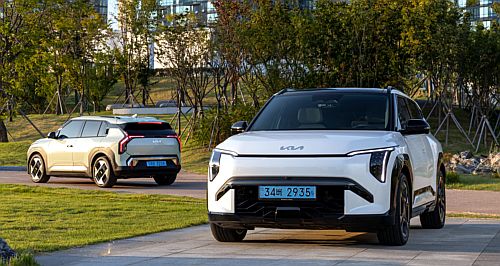Kia Australia issues more EV3 details

IN A move to stay front of mind with potential buyers amid a flood of competition, Kia Australia has issued a statement saying that it remains on track for a March/April 2025 launch of its new fully electric EV3 small SUV.
Apart from a raft of other brands, it will compete with Kia’s existing but slow selling Niro EV for sales, the new model joining a growing line-up of similar boxy-styled BEVs from the South Korean manufacturer.
Details on the EV3 were made public back in May at its international launch in Seoul…apart from pricing, trim and features which remains the case for the time being.
As a possible guide, the Niro EV is listed from $66,590 + ORC and the Niro hybrid from $45,000 + ORC with the additional EV3 BEV conceivably tapping a wider market for “electrified” Kia vehicles.
Built on the Hyundai/Kia E-GMP electrified global modular platform, Kia says the newcomer offers “World-first cutting-edge technologies (that) enable customers to unlock new dimensions from EV3, enhancing driving and ownership experience”.
It has some novel features utilising i-Pedal 3.0 technology that is claimed to provide a more relaxed, efficient driving style and more flexibility in operation coupled with Smart Regenerative Braking System (SRBS) also functioning in reverse gear.
The SRBS 3.0 technology (making its debut in the EV3) provides the driver with a digital co-pilot that can scan the road ahead and respond to situations with lightning-fast reactions.
It is engaged by holding the right-hand steering wheel paddle for more than a second and integrates autonomous driving technology with regenerative braking.
While Kia’s previous Smart Regenerative System relied solely on GPS information, this latest version incorporates a wider variety of navigation-based data, unlocking an array of advantages for the driver.
Newly developed thermal management technology gives EV3 battery efficiency and charging time edge over rivals, even in harsh conditions.
And it offers vehicle-to-load (V2L) charging that can enhance an owner’s interactions with their car, Kia claiming a range of up to 600km (WLTP) and fast-charging capability.
“The EV3’s game-changing blend of attributes means customers needn’t be concerned with making the transition from an internal combustion engine (ICE) car to an electric vehicle (EV),” said Kia in a statement.
Like other brands the EV3 has a driving “coach” to help optimise range.
Mindful of the critical role played by aerodynamics in an EV’s efficiency, Kia engineers went to great lengths to ensure that the EV3 is slippery through the air.
Kia says endless hours were spent in the wind tunnel to hone the EV3’s aerodynamic performance, including subtleties such as the optimised wheel shapes and the enhanced rear combination lamps.
There are also new side sill undercovers, along with eight parts covering the underbody which contribute to cleaner underfloor airflow and reduced drag.
And they did not stop there… the model has “optimised” headlight and front bumper cover profiles, wheel gap reducers, a smooth wheel arch design, a shallower roof spoiler angle, aerodynamic strakes on the rear bumper cover and improved front wheel deflectors creating an impressive drag coefficient of 0.26Cd.
The EV3’s battery is the largest battery in its class at 81.4kWh and is a so called fourth-generation unit also that has approximately 22 per cent higher energy density compared with the Niro EV, which shares the same 400V architecture, and delivers a best-in-class all-electric range of a claimed 600km (WLTP standard).
Kia enthusiastically announces the EV3 is the first vehicle in the world to deploy a simultaneous heat absorption system, enabling it to recycle waste heat not just from the vehicle, but also outside air to optimise efficiency.
The model’s advanced heat pump technology significantly improves its ability to protect battery performance and charge quickly in cold weather.
A high-thermal-efficiency sheath heater and low-temperature charging software allows EV3 owners to spend much less time waiting for their vehicle to charge.
The EV3’s battery is also equipped with a liquid cooling system, which is used during charging to optimise battery thermal management and enhance charging speeds facilitating a rapid charging time up to 12 minutes quicker than the Niro EV, the EV3 recharging from 10 to 80 per cent capacity in 31 minutes (Long Range model, under 350kW fast charging condition).
Consistent cabin conditions are delivered through the EV3’s highly efficient and super-compact thin HVAC (heating, ventilation and air-conditioning) system that provides more cabin space.
As already reported in GoAuto, Kia plans to introduce an all-wheel drive (AWD) variant as well as a GT model, expanding the range of choice for customers beyond the current two-wheel drive (2WD) models.